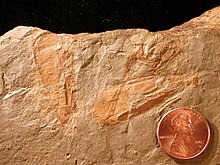| Hyolitha Temporal range: Fortunian to end Permian,
| |
|---|---|

| |
| Hyolithes cerops, Spence Shale, Idaho (Middle Cambrian) | |
| Scientific classification | |
| Domain: | Eukaryota |
| Kingdom: | Animalia |
| Phylum: | Brachiopoda |
| Class: | †Hyolitha Marek, 1963 |
| Orders | |
Hyoliths are animals with small conical shells, known from fossils from the Palaeozoic era. They are at least considered as being lophotrochozoan, and possibly being lophophorates, a group which includes the brachiopods, while others consider them as being basal lophotrochozoans, or even molluscs.[4][5][6]
- ^ Kouchinsky, A.; Bengtson, S.; Runnegar, B.; Skovsted, C.; Steiner, M.; Vendrasco, M. (March 2012). "Chronology of early Cambrian biomineralization". Geological Magazine. 149 (2): 221–251. Bibcode:2012GeoM..149..221K. doi:10.1017/S0016756811000720.
- ^ Cite error: The named reference
ref_was invoked but never defined (see the help page). - ^ Runnegar, Bruce; Pojeta, John; Morris, Noel J.; Taylor, John D.; Taylor, Michael E.; McClung, Graham (1975). "Biology of the Hyolitha". Lethaia. 8 (2): 181. doi:10.1111/j.1502-3931.1975.tb01311.x.
- ^ Cite error: The named reference
ReferenceAwas invoked but never defined (see the help page). - ^ Liu, Fan; Skovsted, Christian B; Topper, Timothy P; Zhang, Zhifei; Shu, Degan (1 February 2020). "Are hyoliths Palaeozoic lophophorates?". National Science Review. 7 (2): 453–469. doi:10.1093/nsr/nwz161. ISSN 2095-5138. PMC 8289160. PMID 34692060.
- ^ Li, Luoyang; Skovsted, Christian B.; Topper, Timothy (August 2022). "Deep origin of the crossed‐lamellar microstructure in early Cambrian molluscs". Palaeontology. 65 (4). doi:10.1111/pala.12620. S2CID 251866827. Retrieved 25 November 2022.